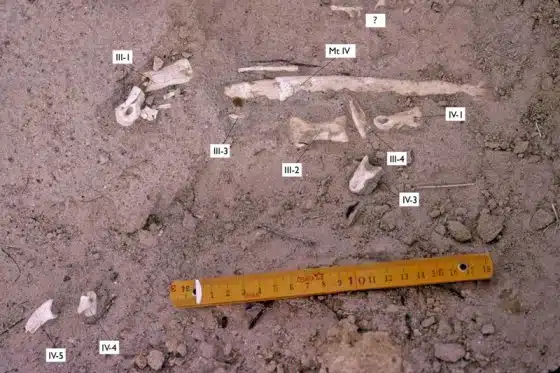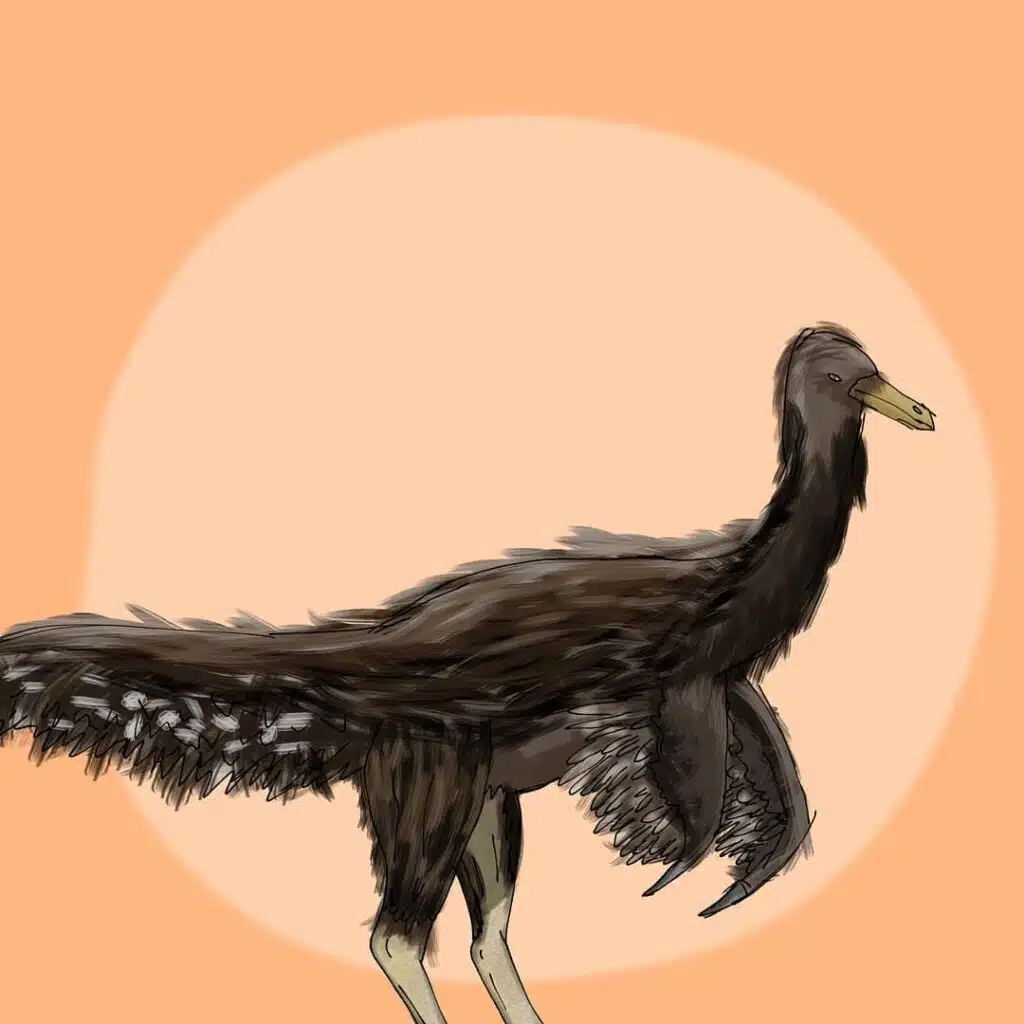In this article, we’re going to embark on a journey back in time to an era when the Earth was a very different place. Our destination is the Late Cretaceous period and our focus is a fascinating dinosaur known as Aepyornithomimus. This dinosaur, whose name might be a bit of a tongue-twister, is a captivating subject of study for paleontologists and dinosaur lovers alike. So, let’s dive in and explore the world of Aepyornithomimus.
Aepyornithomimus Key Facts
| Keyword | Fact |
|---|---|
| Aepyornithomimus pronunciation | Ay-pe-or-nith-o-my-mus |
| Meaning of name | Aepyornis mimic |
| Group | Theropod |
| Type Species | Aepyornithomimus tugrikinensis |
| Diet | Carnivore or omnivore |
| When it Lived | 83.5 to 70.6 MYA |
| Period | Late Cretaceous |
| Epoch | Late/Upper Campanian |
| Length | 7.9 ft |
| Height | 5.0 to 5.9 ft |
| Weight | 0.03 tons |
| Mobility | Moved on two legs |
| First Discovery | 1994 by Shigeru Suzuki |
| Location of first find | Djadokhta Formation, Gobi Desert, Mongolia |
| First Described by | 1997 by Tsogtbaatar Chinzorig, Yoshitsugu Kobayashi, Khishigjav Tsogtbaatar, Philip Currie, Mahito Watabe and Rinchen Barsbold |
| Holotype | MPC-D 100/130 |
Aepyornithomimus Taxonomy and Timeline

Aepyornithomimus, whose name translates to “Aepyornis mimic” in Latin, in reference to the genus of elephant birds, Aepyornis. It is part of the ancestral group to modern birds, Theropoda. This group is known for its members’ bipedal stance and carnivorous or omnivorous diets.
This dinosaur is more specifically a member of the Ornithomimidae family, which is often referred to as the “ostrich dinosaurs” due to their bird-like appearance. Aepyornithomimus tugrikinensis is the only known species within the genus, making it a unique representative of its kind.
This dinosaur lived during the Late Cretaceous period, specifically in the epoch known as the Late/Upper Campanian. This period dates back to a time when the Earth was teeming with a diverse array of dinosaur species.
Discovery & Fossil Evidence
Shigeru Suzuki made the first discovery in 1994 in the Djadokhta Formation of the Gobi Desert, Mongolia. This region is renowned for its rich fossil deposits, making it a treasure trove for paleontologists. The dinosaur was later described in 1997 by a team of researchers including Tsogtbaatar Chinzorig, Yoshitsugu Kobayashi, Khishigjav Tsogtbaatar, Philip J. Currie, Mahito Watabe, and Rinchen Barsbold.

The holotype specimen, designated as MPC-D 100/130, consists of partial foot bones. These fossils provide valuable insights into the evolution of foot morphology in this group of dinosaurs. Further research and discoveries may shed more light on this intriguing dinosaur and its place in the Late Cretaceous ecosystem.
Aepyornithomimus Size and Description
Aepyornithomimus was a unique dinosaur with a set of characteristics that distinguished it from other members of the Ornithomimidae family. Let’s delve deeper into its physical attributes and understand what made this dinosaur stand out.
Short description of Aepyornithomimus
Aepyornithomimus, like other members of the Ornithomimidae family, probably had a bird-like appearance. Its body was likely covered in feathers and it moved on two legs, a characteristic trait of theropods. The dinosaur’s foot bones, as revealed by the holotype specimen, suggest that it had a robust structure capable of supporting its weight as it moved around its environment.
Size and Weight of Type Species
The exact size and weight are currently unknown, as the available fossil evidence is limited to partial foot bones. However, based on comparisons with other members of the Ornithomimidae family, it can be inferred that Aepyornithomimus was a medium-sized dinosaur. Further discoveries and research may provide more precise estimates of its size and weight.
The Dinosaur in Detail
This is a fascinating dinosaur that stands out due to its unique characteristics. As a member of the Ornithomimidae family, it shared many traits with its relatives, such as a bird-like appearance and bipedal locomotion. However, it also had its own unique features that set it apart.
Aepyornithomimus’s foot bones, as revealed by the holotype specimen, provide valuable insights into its lifestyle. The robust structure of its metatarsals suggests that it was a capable runner, able to move swiftly across its environment. This would have been a crucial survival trait, allowing it to escape from predators and hunt for food. These foot bones were more derived than its relatives, suggesting that it had adapted to its environment.
Aepyornithomimus in its Natural Habitat

This dinosaur lived during the Late Cretaceous period in a time when the Earth’s climate was warmer than it is today. The dinosaur’s habitat, the Djadokhta Formation in the Gobi Desert, was likely a semi-arid environment with seasonal rainfall. The landscape would have been dotted with hardy vegetation. Its robust foot bones suggest that it was a capable runner, able to chase after prey or escape from predators. The dinosaur’s adaptability would have been a key factor in its survival in the harsh desert environment.
Aepyornithomimus, like other dinosaurs of its time, would have played a crucial role in shaping the ecosystem around it. As a carnivore or omnivore, it would have helped to control plant and small animal populations and contributed to the balance of the ecosystem. Its interactions with other dinosaurs and its environment provide fascinating insights into the dynamics of the Late Cretaceous ecosystem.
Interesting Points about Aepyornithomimus
- The robust foot bones suggest that it was a capable runner–a crucial survival trait in the Late Cretaceous ecosystem.
- It was discovered in the Djadokhta Formation of the Gobi Desert, a region renowned for its rich fossil deposits.
- It lived during the Late Cretaceous period, a time when the Earth was teeming with a diverse array of dinosaur species.
- The more advanced morphology of the foot bones suggests that this dinosaur had adapted to a more specific habitat or behavior than its more primitive relatives.
Contemporary Dinosaurs
In the sun-drenched expanses of the Late Cretaceous period, the nimble Aepyornithomimus danced its way through a world of giants. Picture a landscape teeming with life where Aepyornithomimus, no larger than a modern ostrich, navigated its way through the towering legs of the colossal Tarbosaurus–a predator roughly three times its size. The frighteningly powerful jaws of Tarbosaurus were a constant reminder of the precarious balance of life and death in this prehistoric world. Yet, the swift Aepyornithomimus could use its keen senses and quick reflexes to evade the clutches of this fearsome predator.
Aepyornithomimus shared its world not only with predators but also with herbivores such as Saurolophus and Nemegtosaurus. The duck-billed Saurolophus was roughly the same size as the Tarbosaurus, while the long-necked Nemegtosaurus was even larger. These gentle giants, grazing peacefully on the lush vegetation, were often oblivious to the smaller Aepyornithomimus darting between their legs.
Yet, it wasn’t always a peaceful coexistence. Aepyornithomimus often found itself in a race against Deinocheirus, a dinosaur of similar size but with a much larger appetite. These two would compete fiercely for food, their paths crossing at the most bountiful feeding grounds. The speed and agility of Aepyornithomimus may have managed to snatch up the choicest morsels before the slower Deinocheirus could reach them.
In this vibrant ecosystem, Aepyornithomimus played a vital role. Its interactions with its contemporaries–whether as a potential prey, a competitor, or simply a fellow inhabitant–shaped its existence. Through these relationships we gain a deeper understanding of Aepyornithomimus’s life and environment. They paint a vivid picture of a world long lost to time where every creature, no matter how small, had a role to play in the grand tapestry of life.
List of All Dinosaurs
We have created a list of all dinosaurs we have covered here, sorted across the seven main groups of dinosaurs. We also include information about their type of diet, (omnivore, herbivore or carnivore) and the time they lived.
Frequently Asked Questions
The name translates to “Aepyornis mimic” in Latin. This comes from its presumed resemblance to the extinct elephant bird, Aepyornis.
The Aepyornithomimus belongs to the Theropoda group of dinosaurs. It is part of the Ornithomimidae family.
This dinosaur lived during the Late Cretaceous period, approximately 83.5 to 70.6 million years ago.
The first fossil was discovered in the Djadokhta Formation of the Gobi Desert, Mongolia.
Shigeru Suzuki discovered the Aepyornithomimus in 1994.
Sources
The information in this article is based on various sources, drawing on scientific research, fossil evidence, and expert analysis. The aim is to provide a comprehensive and accurate overview of the Aepyornithomimus. However, as new discoveries are made, our understanding of dinosaurs and their world is constantly evolving.
Article last fact checked: Joey Arboleda, 07-26-2023
Featured Image Credit: Masato Hattori, CC BY-SA 4.0, via Wikimedia Commons
